spare wheel Hyundai Equus 2016 Owner's Manual
[x] Cancel search | Manufacturer: HYUNDAI, Model Year: 2016, Model line: Equus, Model: Hyundai Equus 2016Pages: 477, PDF Size: 16.25 MB
Page 340 of 477
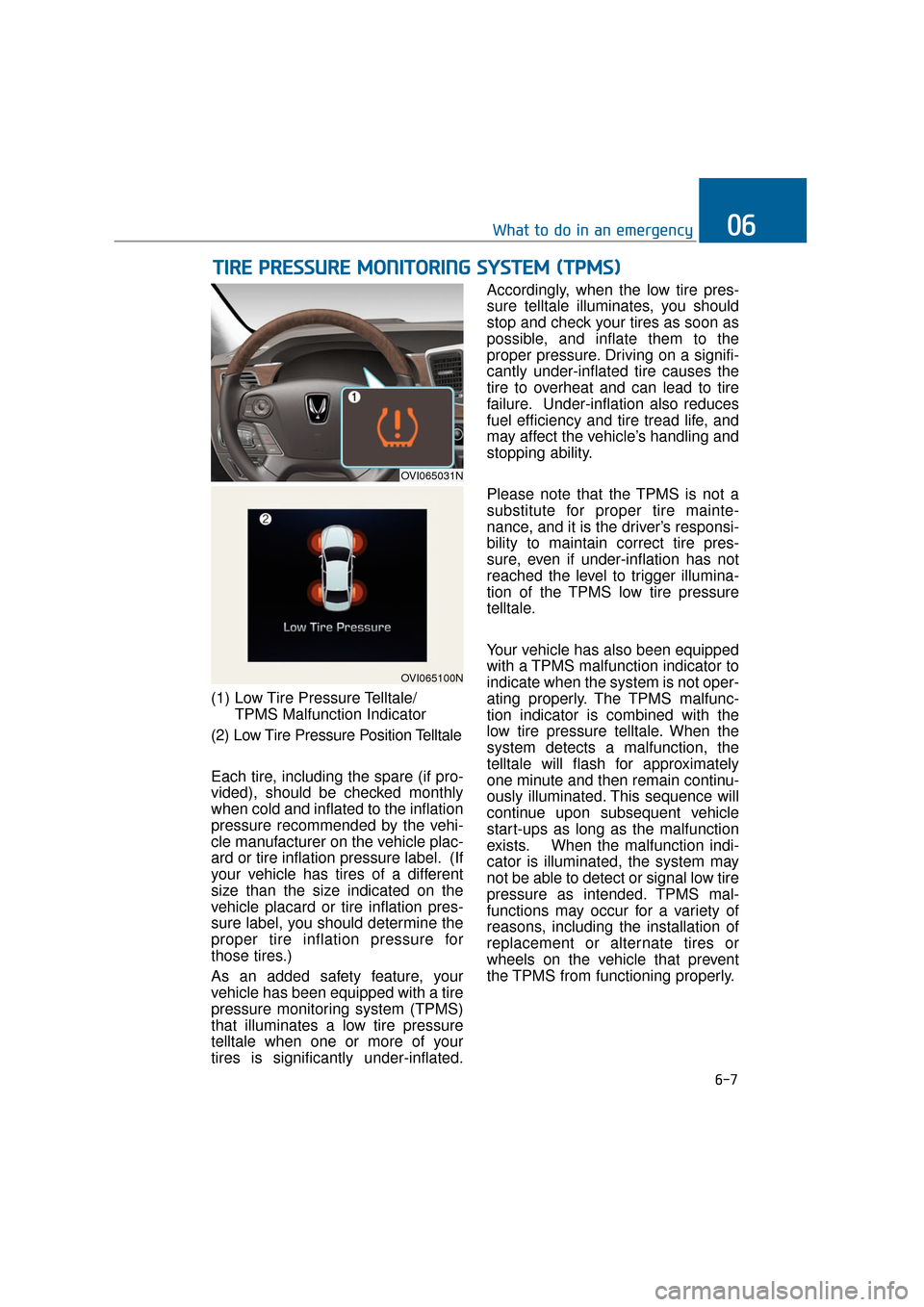
(1) Low Tire Pressure Telltale/TPMS Malfunction Indicator
(2) Low Tire Pressure Position Telltale
Each tire, including the spare (if pro-
vided), should be checked monthly
when cold and inflated to the inflation
pressure recommended by the vehi-
cle manufacturer on the vehicle plac-
ard or tire inflation pressure label. (If
your vehicle has tires of a different
size than the size indicated on the
vehicle placard or tire inflation pres-
sure label, you should determine the
proper tire inflation pressure for
those tires.)
As an added safety feature, your
vehicle has been equipped with a tire
pressure monitoring system (TPMS)
that illuminates a low tire pressure
telltale when one or more of your
tires is significantly under-inflated. Accordingly, when the low tire pres-
sure telltale illuminates, you should
stop and check your tires as soon as
possible, and inflate them to the
proper pressure. Driving on a signifi-
cantly under-inflated tire causes the
tire to overheat and can lead to tire
failure. Under-inflation also reduces
fuel efficiency and tire tread life, and
may affect the vehicle’s handling and
stopping ability.
Please note that the TPMS is not a
substitute for proper tire mainte-
nance, and it is the driver’s responsi-
bility to maintain correct tire pres-
sure, even if under-inflation has not
reached the level to trigger illumina-
tion of the TPMS low tire pressure
telltale.
Your vehicle has also been equipped
with a TPMS malfunction indicator to
indicate when the system is not oper-
ating properly. The TPMS malfunc-
tion indicator is combined with the
low tire pressure telltale. When the
system detects a malfunction, the
telltale will flash for approximately
one minute and then remain continu-
ously illuminated. This sequence will
continue upon subsequent vehicle
start-ups as long as the malfunction
exists. When the malfunction indi-
cator is illuminated, the system may
not be able to detect or signal low tire
pressure as intended. TPMS mal-
functions may occur for a variety of
reasons, including the installation of
replacement or alternate tires or
wheels on the vehicle that prevent
the TPMS from functioning properly.
T T
I
IR
R E
E
P
P R
R E
ES
SS
SU
U R
RE
E
M
M O
ON
NI
IT
T O
O R
RI
IN
N G
G
S
S Y
Y S
ST
T E
EM
M
(
( T
T P
P M
M S
S)
)
6-7
What to do in an emergency06
OVI065031N
OVI065100N
Page 341 of 477
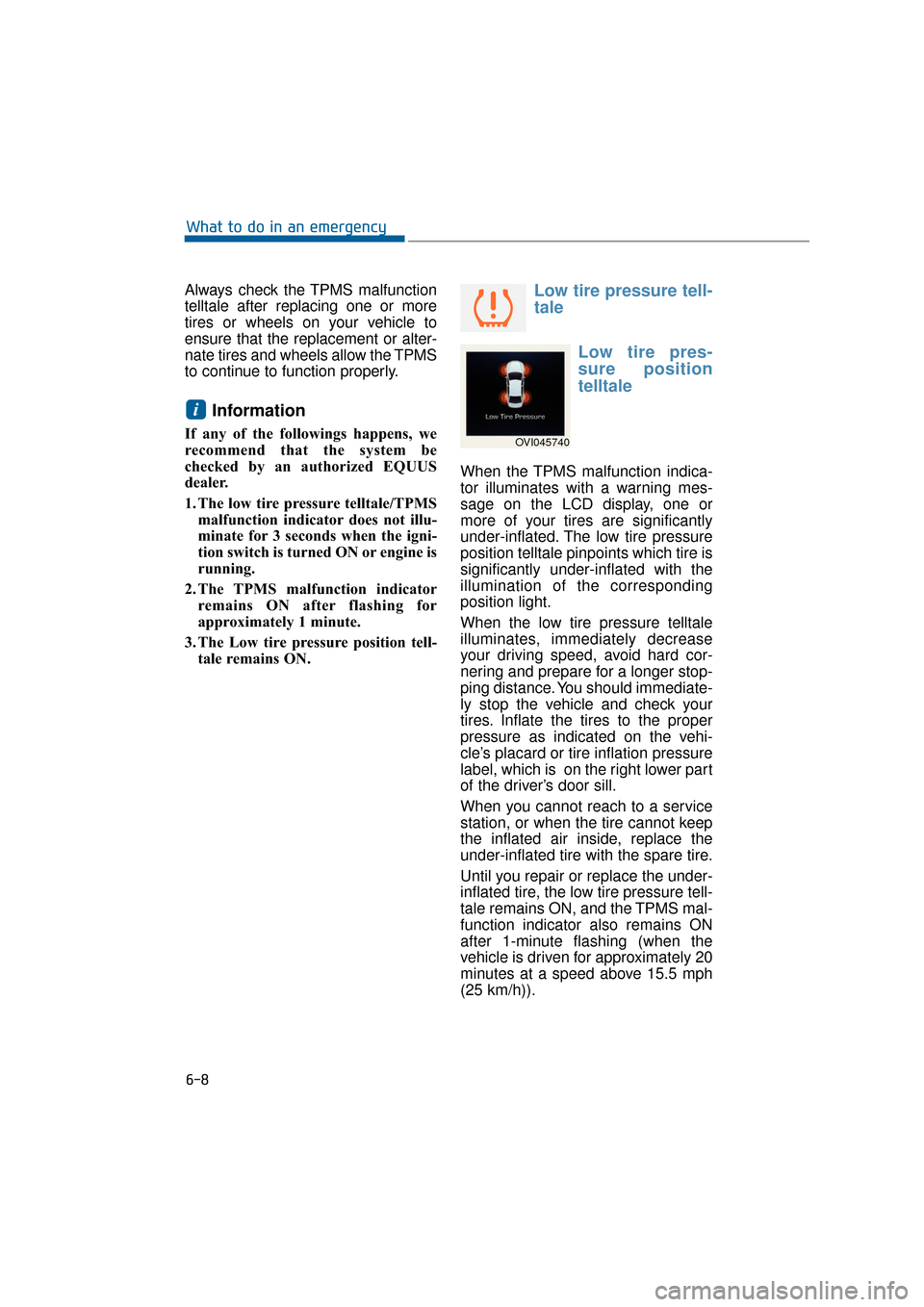
Always check the TPMS malfunction
telltale after replacing one or more
tires or wheels on your vehicle to
ensure that the replacement or alter-
nate tires and wheels allow the TPMS
to continue to function properly.
Information
If any of the followings happens, we
recommend that the system be
checked by an authorized EQUUS
dealer.
1. The low tire pressure telltale/TPMSmalfunction indicator does not illu-
minate for 3 seconds when the igni-
tion switch is turned ON or engine is
running.
2. The TPMS malfunction indicator remains ON after flashing for
approximately 1 minute.
3. The Low tire pressure position tell- tale remains ON.
Low tire pressure tell-
tale
Low tire pres-
sure position
telltale
When the TPMS malfunction indica-
tor illuminates with a warning mes-
sage on the LCD display, one or
more of your tires are significantly
under-inflated. The low tire pressure
position telltale pinpoints which tire is
significantly under-inflated with the
illumination of the corresponding
position light.
When the low tire pressure telltale
illuminates, immediately decrease
your driving speed, avoid hard cor-
nering and prepare for a longer stop-
ping distance. You should immediate-
ly stop the vehicle and check your
tires. Inflate the tires to the proper
pressure as indicated on the vehi-
cle’s placard or tire inflation pressure
label, which is on the right lower part
of the driver’s door sill.
When you cannot reach to a service
station, or when the tire cannot keep
the inflated air inside, replace the
under-inflated tire with the spare tire.
Until you repair or replace the under-
inflated tire, the low tire pressure tell-
tale remains ON, and the TPMS mal-
function indicator also remains ON
after 1-minute flashing (when the
vehicle is driven for approximately 20
minutes at a speed above 15.5 mph
(25 km/h)).
i
6-8
What to do in an emergency
OVI045740
Page 343 of 477
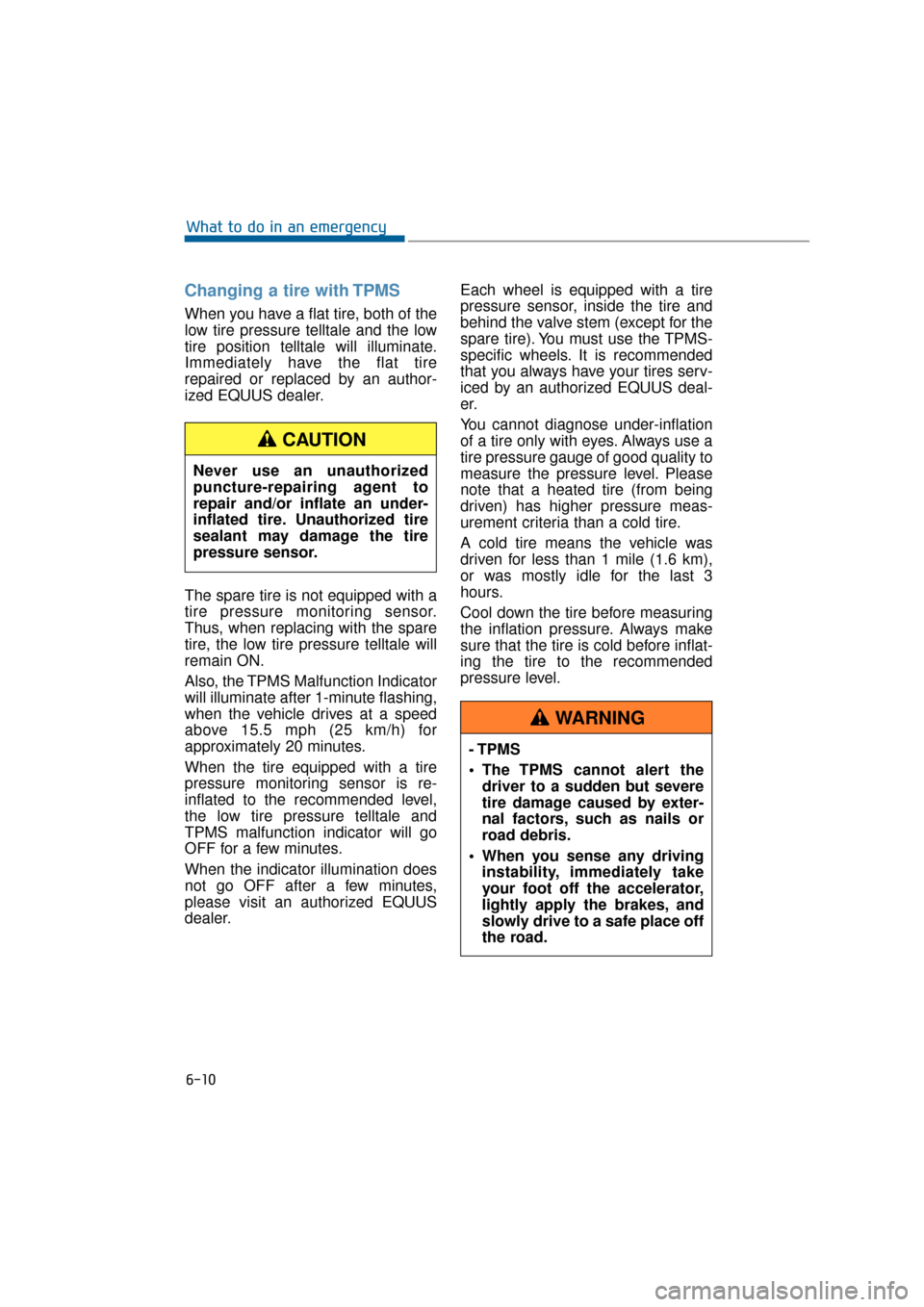
Changing a tire with TPMS
When you have a flat tire, both of the
low tire pressure telltale and the low
tire position telltale will illuminate.
Immediately have the flat tire
repaired or replaced by an author-
ized EQUUS dealer.
The spare tire is not equipped with a
tire pressure monitoring sensor.
Thus, when replacing with the spare
tire, the low tire pressure telltale will
remain ON.
Also, the TPMS Malfunction Indicator
will illuminate after 1-minute flashing,
when the vehicle drives at a speed
above 15.5 mph (25 km/h) for
approximately 20 minutes.
When the tire equipped with a tire
pressure monitoring sensor is re-
inflated to the recommended level,
the low tire pressure telltale and
TPMS malfunction indicator will go
OFF for a few minutes.
When the indicator illumination does
not go OFF after a few minutes,
please visit an authorized EQUUS
dealer.Each wheel is equipped with a tire
pressure sensor, inside the tire and
behind the valve stem (except for the
spare tire). You must use the TPMS-
specific wheels. It is recommended
that you always have your tires serv-
iced by an authorized EQUUS deal-
er.
You cannot diagnose under-inflation
of a tire only with eyes. Always use a
tire pressure gauge of good quality to
measure the pressure level. Please
note that a heated tire (from being
driven) has higher pressure meas-
urement criteria than a cold tire.
A cold tire means the vehicle was
driven for less than 1 mile (1.6 km),
or was mostly idle for the last 3
hours.
Cool down the tire before measuring
the inflation pressure. Always make
sure that the tire is cold before inflat-
ing the tire to the recommended
pressure level.
6-10
What to do in an emergency
Never use an unauthorized
puncture-repairing agent to
repair and/or inflate an under-
inflated tire. Unauthorized tire
sealant may damage the tire
pressure sensor.
CAUTION
- TPMS
The TPMS cannot alert the driver to a sudden but severe
tire damage caused by exter-
nal factors, such as nails or
road debris.
When you sense any driving instability, immediately take
your foot off the accelerator,
lightly apply the brakes, and
slowly drive to a safe place off
the road.
WARNING
Page 346 of 477
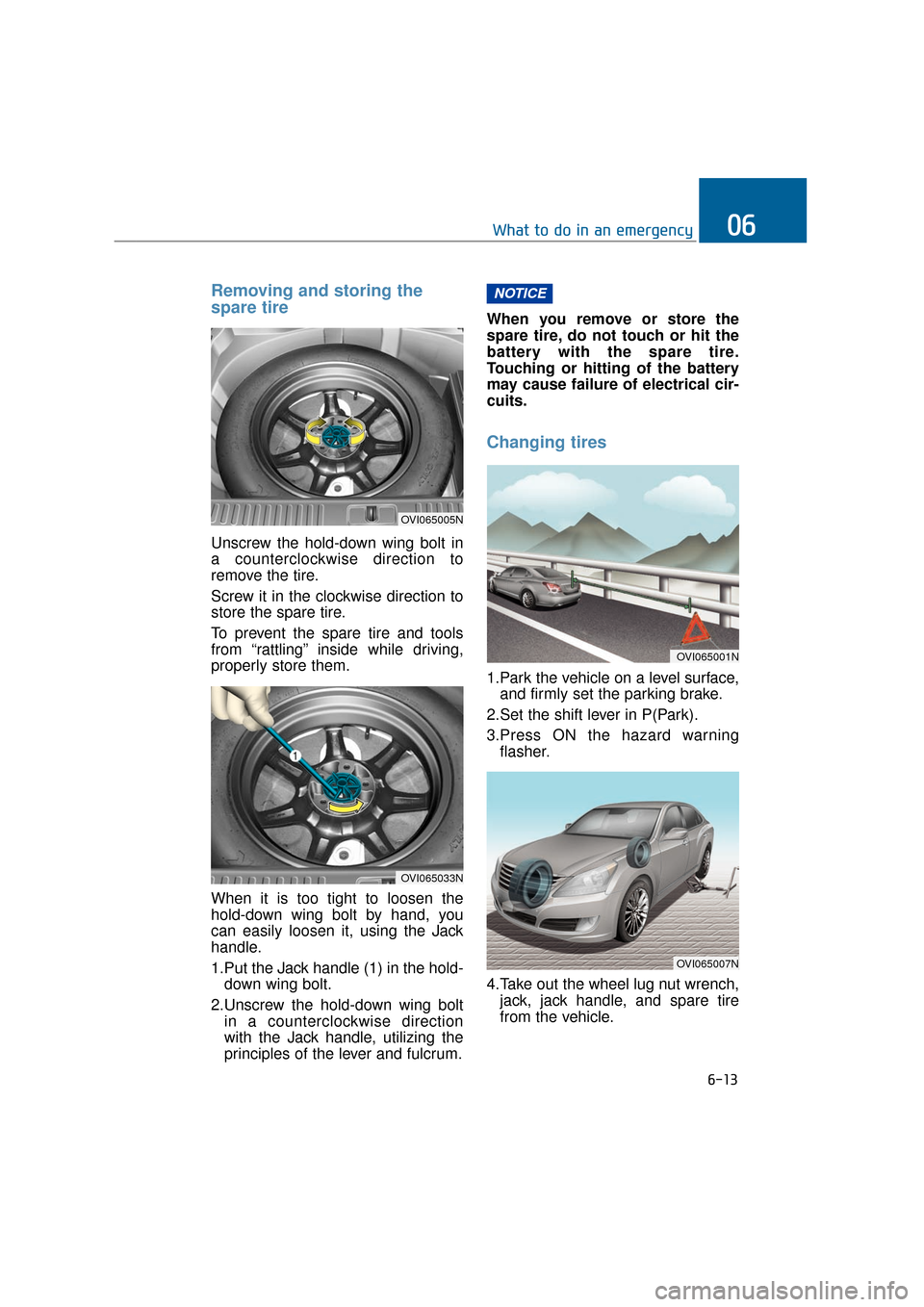
Removing and storing the
spare tire
Unscrew the hold-down wing bolt in
a counterclockwise direction to
remove the tire.
Screw it in the clockwise direction to
store the spare tire.
To prevent the spare tire and tools
from “rattling” inside while driving,
properly store them.
When it is too tight to loosen the
hold-down wing bolt by hand, you
can easily loosen it, using the Jack
handle.
1.Put the Jack handle (1) in the hold-down wing bolt.
2.Unscrew the hold-down wing bolt in a counterclockwise direction
with the Jack handle, utilizing the
principles of the lever and fulcrum. When you remove or store the
spare tire, do not touch or hit the
battery with the spare tire.
Touching or hitting of the battery
may cause failure of electrical cir-
cuits.
Changing tires
1.Park the vehicle on a level surface,
and firmly set the parking brake.
2.Set the shift lever in P(Park).
3.Press ON the hazard warning flasher.
4.Take out the wheel lug nut wrench, jack, jack handle, and spare tire
from the vehicle.
NOTICE
6-13
What to do in an emergency06
OVI065005N
OVI065033N
OVI065001N
OVI065007N
Page 348 of 477
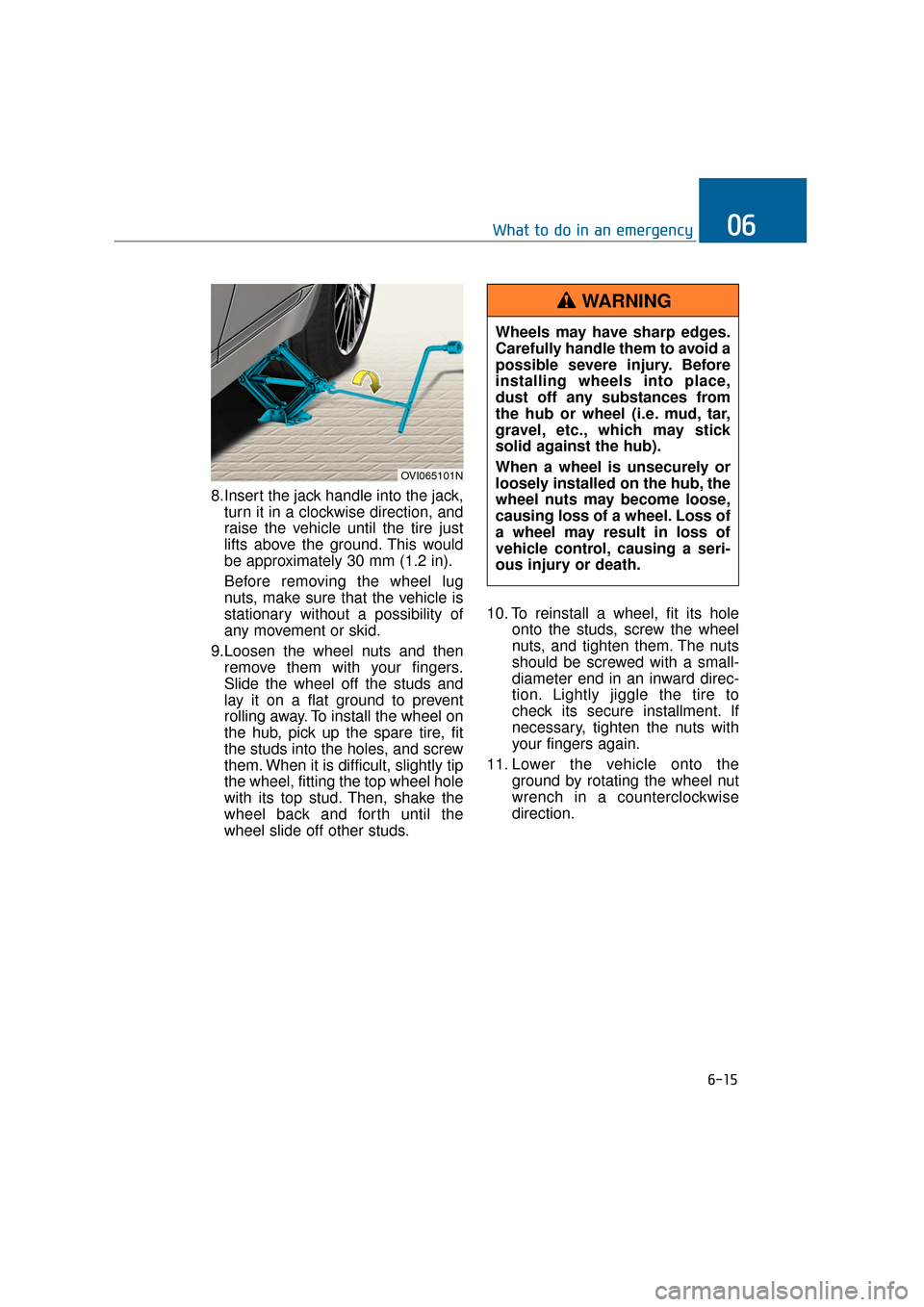
8.Insert the jack handle into the jack,turn it in a clockwise direction, and
raise the vehicle until the tire just
lifts above the ground. This would
be approximately 30 mm (1.2 in).
Before removing the wheel lug
nuts, make sure that the vehicle is
stationary without a possibility of
any movement or skid.
9.Loosen the wheel nuts and then remove them with your fingers.
Slide the wheel off the studs and
lay it on a flat ground to prevent
rolling away. To install the wheel on
the hub, pick up the spare tire, fit
the studs into the holes, and screw
them. When it is difficult, slightly tip
the wheel, fitting the top wheel hole
with its top stud. Then, shake the
wheel back and forth until the
wheel slide off other studs. 10. To reinstall a wheel, fit its hole
onto the studs, screw the wheel
nuts, and tighten them. The nuts
should be screwed with a small-
diameter end in an inward direc-
tion. Lightly jiggle the tire to
check its secure installment. If
necessary, tighten the nuts with
your fingers again.
11. Lower the vehicle onto the ground by rotating the wheel nut
wrench in a counterclockwise
direction.
6-15
What to do in an emergency06
Wheels may have sharp edges.
Carefully handle them to avoid a
possible severe injury. Before
installing wheels into place,
dust off any substances from
the hub or wheel (i.e. mud, tar,
gravel, etc., which may stick
solid against the hub).
When a wheel is unsecurely or
loosely installed on the hub, the
wheel nuts may become loose,
causing loss of a wheel. Loss of
a wheel may result in loss of
vehicle control, causing a seri-
ous injury or death.
WARNING
OVI065101N
Page 350 of 477
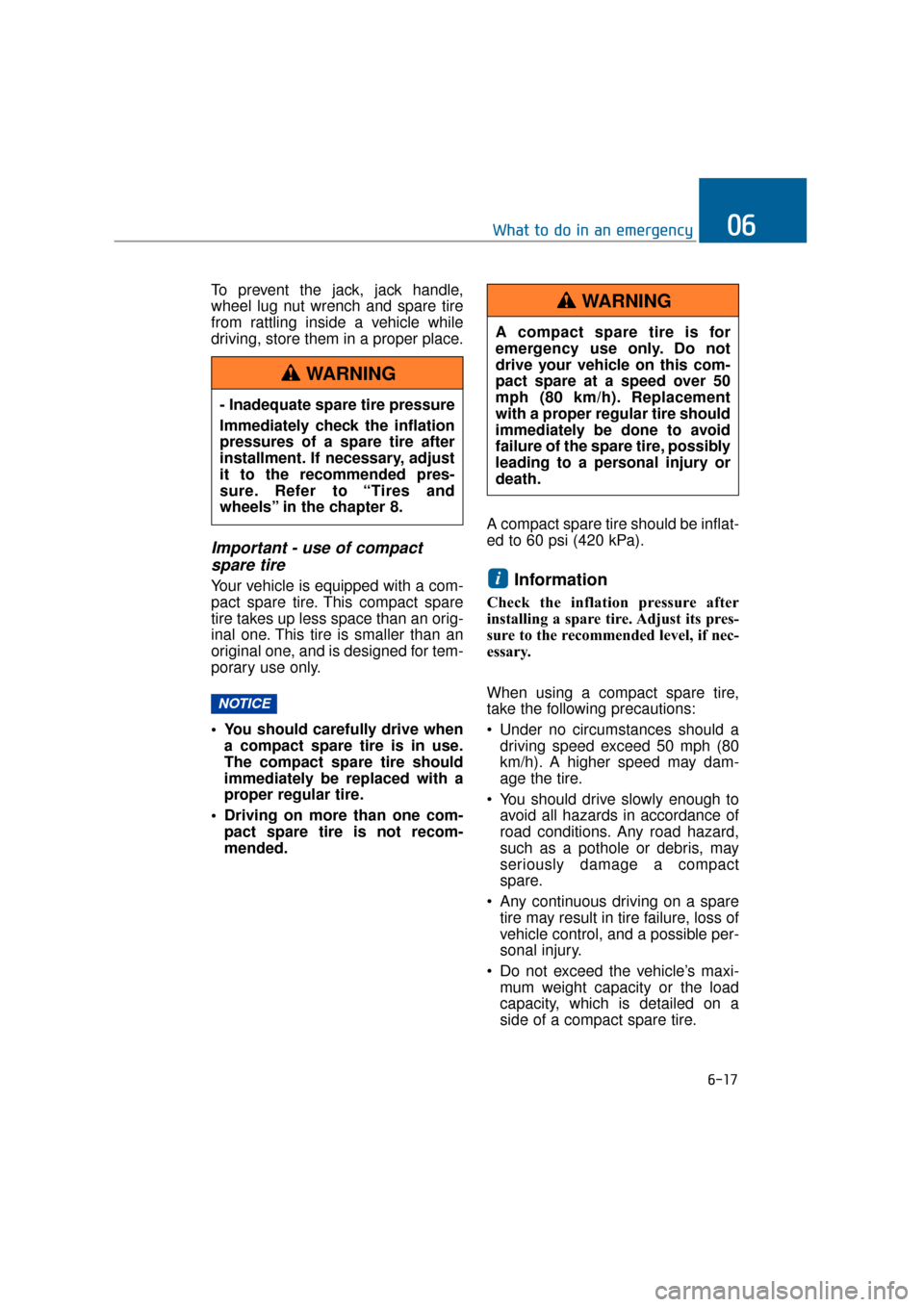
To prevent the jack, jack handle,
wheel lug nut wrench and spare tire
from rattling inside a vehicle while
driving, store them in a proper place.
Important - use of compactspare tire
Your vehicle is equipped with a com-
pact spare tire. This compact spare
tire takes up less space than an orig-
inal one. This tire is smaller than an
original one, and is designed for tem-
porary use only.
You should carefully drive when
a compact spare tire is in use.
The compact spare tire should
immediately be replaced with a
proper regular tire.
Driving on more than one com- pact spare tire is not recom-
mended. A compact spare tire should be inflat-
ed to 60 psi (420 kPa).Information
Check the inflation pressure after
installing a spare tire. Adjust its pres-
sure to the recommended level, if nec-
essary.
When using a compact spare tire,
take the following precautions:
Under no circumstances should a
driving speed exceed 50 mph (80
km/h). A higher speed may dam-
age the tire.
You should drive slowly enough to avoid all hazards in accordance of
road conditions. Any road hazard,
such as a pothole or debris, may
seriously damage a compact
spare.
Any continuous driving on a spare tire may result in tire failure, loss of
vehicle control, and a possible per-
sonal injury.
Do not exceed the vehicle’s maxi- mum weight capacity or the load
capacity, which is detailed on a
side of a compact spare tire.
i
NOTICE
6-17
What to do in an emergency06
- Inadequate spare tire pressure
Immediately check the inflation
pressures of a spare tire after
installment. If necessary, adjust
it to the recommended pres-
sure. Refer to “Tires and
wheels” in the chapter 8.
WARNING
A compact spare tire is for
emergency use only. Do not
drive your vehicle on this com-
pact spare at a speed over 50
mph (80 km/h). Replacement
with a proper regular tire should
immediately be done to avoid
failure of the spare tire, possibly
leading to a personal injury or
death.
WARNING
Page 351 of 477
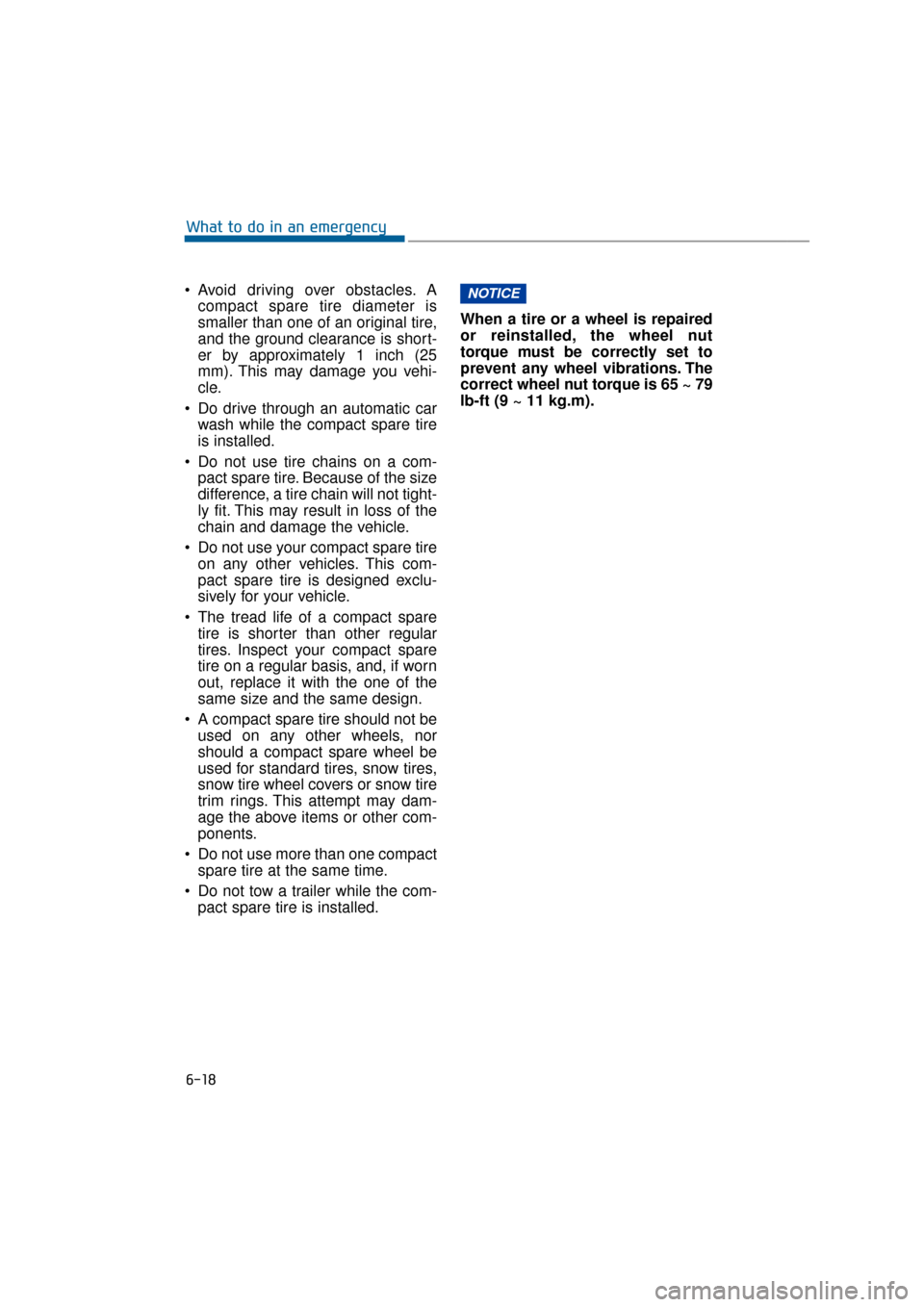
Avoid driving over obstacles. Acompact spare tire diameter is
smaller than one of an original tire,
and the ground clearance is short-
er by approximately 1 inch (25
mm). This may damage you vehi-
cle.
Do drive through an automatic car wash while the compact spare tire
is installed.
Do not use tire chains on a com- pact spare tire. Because of the size
difference, a tire chain will not tight-
ly fit. This may result in loss of the
chain and damage the vehicle.
Do not use your compact spare tire on any other vehicles. This com-
pact spare tire is designed exclu-
sively for your vehicle.
The tread life of a compact spare tire is shorter than other regular
tires. Inspect your compact spare
tire on a regular basis, and, if worn
out, replace it with the one of the
same size and the same design.
A compact spare tire should not be used on any other wheels, nor
should a compact spare wheel be
used for standard tires, snow tires,
snow tire wheel covers or snow tire
trim rings. This attempt may dam-
age the above items or other com-
ponents.
Do not use more than one compact spare tire at the same time.
Do not tow a trailer while the com- pact spare tire is installed. When a tire or a wheel is repaired
or reinstalled, the wheel nut
torque must be correctly set to
prevent any wheel vibrations. The
correct wheel nut torque is 65 ~ 79
lb-ft (9 ~ 11 kg.m).NOTICE
6-18
What to do in an emergency
Page 364 of 477
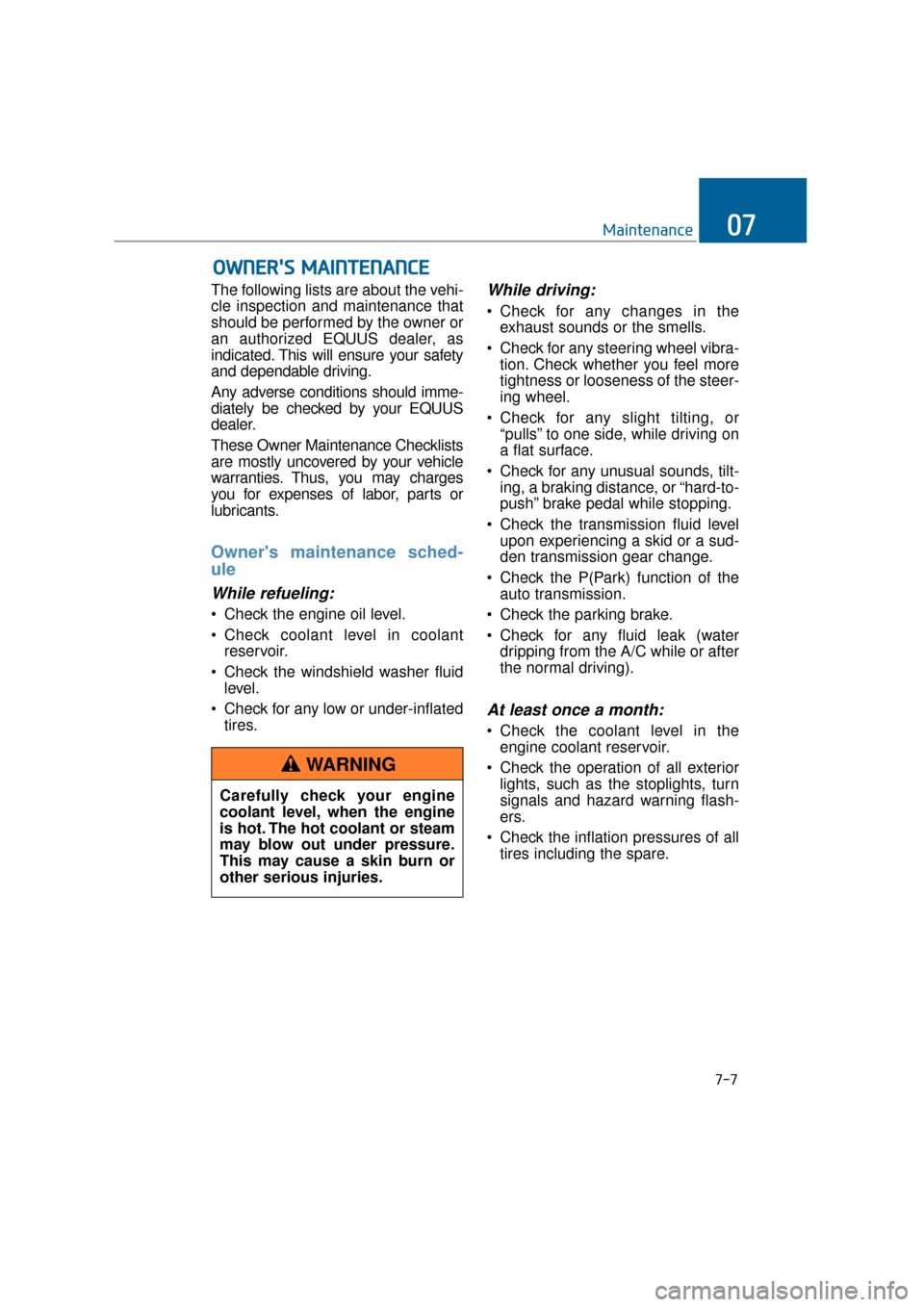
The following lists are about the vehi-
cle inspection and maintenance that
should be performed by the owner or
an authorized EQUUS dealer, as
indicated. This will ensure your safety
and dependable driving.
Any adverse conditions should imme-
diately be checked by your EQUUS
dealer.
These Owner Maintenance Checklists
are mostly uncovered by your vehicle
warranties. Thus, you may charges
you for expenses of labor, parts or
lubricants.
Owner's maintenance sched-
ule
While refueling:
Check the engine oil level.
Check coolant level in coolantreservoir.
Check the windshield washer fluid level.
Check for any low or under-inflated tires.
While driving:
Check for any changes in theexhaust sounds or the smells.
Check for any steering wheel vibra- tion. Check whether you feel more
tightness or looseness of the steer-
ing wheel.
Check for any slight tilting, or “pulls” to one side, while driving on
a flat surface.
Check for any unusual sounds, tilt- ing, a braking distance, or “hard-to-
push” brake pedal while stopping.
Check the transmission fluid level upon experiencing a skid or a sud-
den transmission gear change.
Check the P(Park) function of the auto transmission.
Check the parking brake.
Check for any fluid leak (water dripping from the A/C while or after
the normal driving).
At least once a month:
Check the coolant level in theengine coolant reservoir.
Check the operation of all exterior lights, such as the stoplights, turn
signals and hazard warning flash-
ers.
Check the inflation pressures of all tires including the spare.
O OW
W N
NE
ER
R '
'S
S
M
M A
AI
IN
N T
TE
EN
N A
AN
N C
CE
E
7-7
Maintenance07
Carefully check your engine
coolant level, when the engine
is hot. The hot coolant or steam
may blow out under pressure.
This may cause a skin burn or
other serious injuries.
WARNING
Page 399 of 477
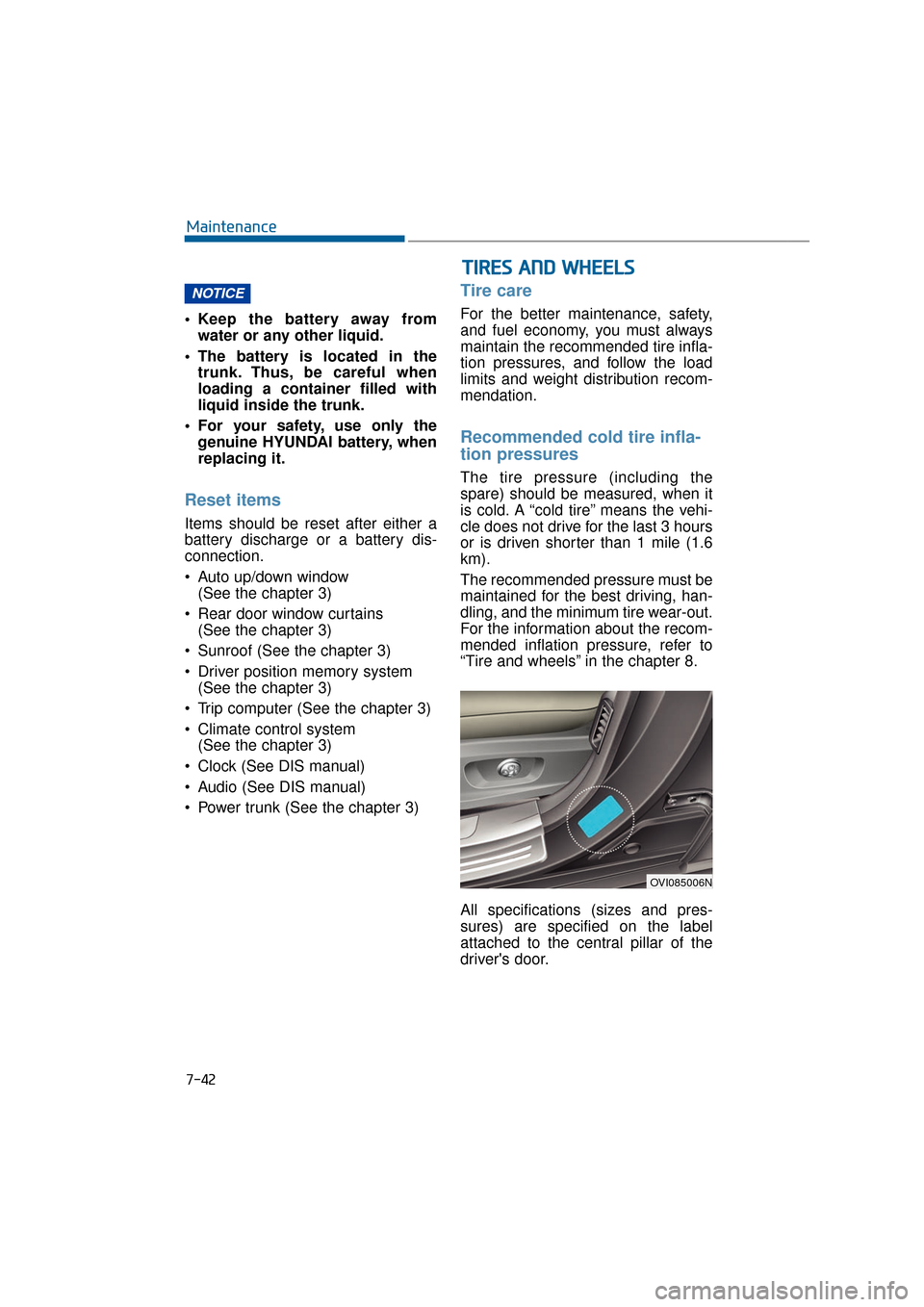
7-42
Maintenance
Keep the battery away from water or any other liquid.
The battery is located in the trunk. Thus, be careful when
loading a container filled with
liquid inside the trunk.
For your safety, use only the genuine HYUNDAI battery, when
replacing it.
Reset items
Items should be reset after either a
battery discharge or a battery dis-
connection.
Auto up/down window (See the chapter 3)
Rear door window curtains (See the chapter 3)
Sunroof (See the chapter 3)
Driver position memory system (See the chapter 3)
Trip computer (See the chapter 3)
Climate control system (See the chapter 3)
Clock (See DIS manual)
Audio (See DIS manual)
Power trunk (See the chapter 3)
Tire care
For the better maintenance, safety,
and fuel economy, you must always
maintain the recommended tire infla-
tion pressures, and follow the load
limits and weight distribution recom-
mendation.
Recommended cold tire infla-
tion pressures
The tire pressure (including the
spare) should be measured, when it
is cold. A “cold tire” means the vehi-
cle does not drive for the last 3 hours
or is driven shorter than 1 mile (1.6
km).
The recommended pressure must be
maintained for the best driving, han-
dling, and the minimum tire wear-out.
For the information about the recom-
mended inflation pressure, refer to
“Tire and wheels” in the chapter 8.
All specifications (sizes and pres-
sures) are specified on the label
attached to the central pillar of the
driver's door.
NOTICE
T T I
IR
R E
ES
S
A
A N
N D
D
W
W H
HE
EE
EL
LS
S
OVI085006N
Page 400 of 477
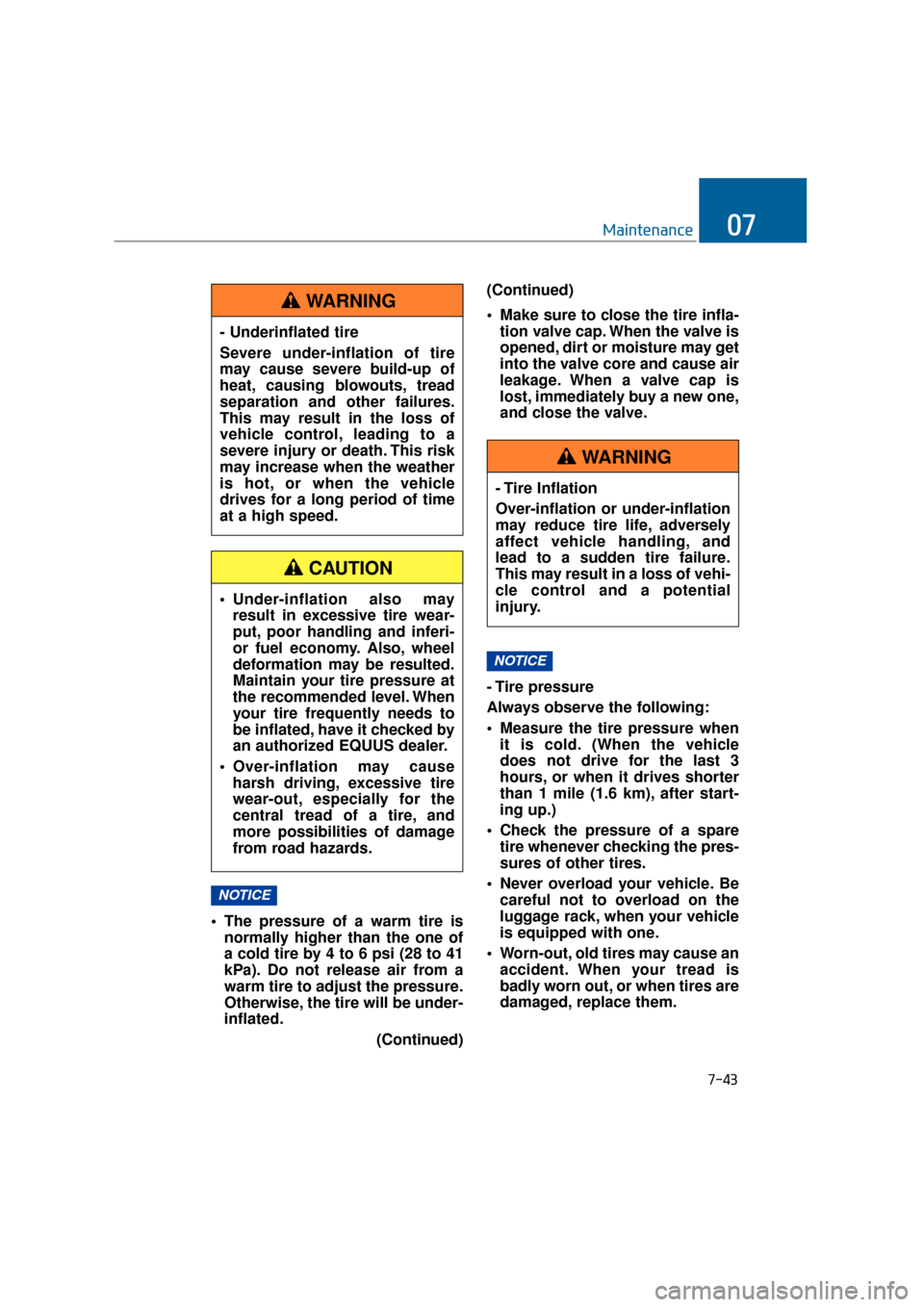
7-43
Maintenance07
The pressure of a warm tire isnormally higher than the one of
a cold tire by 4 to 6 psi (28 to 41
kPa). Do not release air from a
warm tire to adjust the pressure.
Otherwise, the tire will be under-
inflated.
(Continued)(Continued)
Make sure to close the tire infla-
tion valve cap. When the valve is
opened, dirt or moisture may get
into the valve core and cause air
leakage. When a valve cap is
lost, immediately buy a new one,
and close the valve.
- Tire pressure
Always observe the following:
Measure the tire pressure when it is cold. (When the vehicle
does not drive for the last 3
hours, or when it drives shorter
than 1 mile (1.6 km), after start-
ing up.)
Check the pressure of a spare tire whenever checking the pres-
sures of other tires.
Never overload your vehicle. Be careful not to overload on the
luggage rack, when your vehicle
is equipped with one.
Worn-out, old tires may cause an accident. When your tread is
badly worn out, or when tires are
damaged, replace them.
NOTICE
NOTICE
- Underinflated tire
Severe under-inflation of tire
may cause severe build-up of
heat, causing blowouts, tread
separation and other failures.
This may result in the loss of
vehicle control, leading to a
severe injury or death. This risk
may increase when the weather
is hot, or when the vehicle
drives for a long period of time
at a high speed.
WARNING
- Tire Inflation
Over-inflation or under-inflation
may reduce tire life, adversely
affect vehicle handling, and
lead to a sudden tire failure.
This may result in a loss of vehi-
cle control and a potential
injury.
WARNING
Under-inflation also mayresult in excessive tire wear-
put, poor handling and inferi-
or fuel economy. Also, wheel
deformation may be resulted.
Maintain your tire pressure at
the recommended level. When
your tire frequently needs to
be inflated, have it checked by
an authorized EQUUS dealer.
Over-inflation may cause harsh driving, excessive tire
wear-out, especially for the
central tread of a tire, and
more possibilities of damage
from road hazards.
CAUTION